Mucoadhesive and Rheological Studies on the Co-Hydrogel Systems of Poly(Ethylene Glycol) Copolymers with Fluoroalkyl and Poly(Acrylic Acid)
Abstract
:1. Introduction
2. Materials and Methods
2.1. Materials
2.2. Synthesis of Double Ended Rf-PEG (Fluoroalkyl Double-Ended Poly(Ethylene Glycol) (Rf-PEG-Rf))
2.3. Synthesis of Rf-PEG-g-PAA (Poly(Acrylic Acid))
2.4. Preparation of the Rf-PEG-Rf and Rf-PEG-g-PAA Co-Hydrogels
2.5. Molecular Weight and Structural Characterizations Using Matrix-Assisted Laser Desorption/Ionization-Time of Flight (MALDI-TOF) Mass Spectrometry (MS) and Nuclear Magnetic Resonance (NMR) Instruments
2.6. Mucoadhesion Study by Tensile Strength Method
2.7. Rheological Measurements
3. Results and Discussion
3.1. Chemical Analysis of the Product
3.2. Mucoadhesion by Tensile Tests
3.3. Gel Structural Integrity by Rheological Analysis
3.3.1. Shear Strain Amplitude Sweep
3.3.2. Frequency Sweep
4. Conclusions
Supplementary Materials
Author Contributions
Funding
Institutional Review Board Statement
Data Availability Statement
Conflicts of Interest
References
- Peppas, N.A.; Little, M.D.; Huang, Y. Bioadhesive controlled release systems. In Handbook of Pharmaceutical Controlled Release Technology; Wise, D.L., Brannon-Peppas, L., Klibanov, A.M., Langer, R.L., Mikos, A.G., Peppas, N.A., Trantolo, D.J., Wnek, G.E., Yaszemski, M.J., Eds.; Dekker: New York, NY, USA, 2000; pp. 255–269. [Google Scholar]
- Robinson, J.R.; Lee, J.W.; Park, J.H. Bioadhesive-based dosage forms: The next generation. J. Pharm. Sci. 2000, 89, 850–866. [Google Scholar]
- Peppas, N.A.; Bures, P.; Leobandung, W.; Ichikawa, H. Hydrogels in pharmaceutical formulations. Eur J. Pharm. Biopharm. 2000, 50, 27–46. [Google Scholar] [CrossRef]
- Harris, J.M. Ploy(ethylene glycol) Chemistry. Biotechnical and Biomedical Applications; Plenum Press: New York, NY, USA, 1992. [Google Scholar]
- Zalipsky, S. Functionalized Poly(ethylene glycol) for Preparation of Biologically Relevant Conjugates. Bioconjugate Chem. 1995, 6, 150–165. [Google Scholar] [CrossRef]
- Marshall, D.; Pedley, R.B.; Boden, J.A.; Boden, R.; Melton, R.G.; Begent, R.H. Polyethylene glycol modification of a galactosylated streptavidin clearing agent: Effects on immunogenicity and clearance of a biotinylated anti-tumour antibody. Br. J. Cancer 1996, 73, 565–572. [Google Scholar] [CrossRef] [Green Version]
- Harris, J.M.; Chess, R.B. Effect of pegylation on pharmaceuticals. Nat. Rev. Drug Discov. 2003, 2, 214–221. [Google Scholar] [CrossRef]
- Hirai, Y.; Terashima, T.; Takenaka, M.; Sawamoto, M. Precision Self-Assembly of Amphiphilic Random Copolymers into Uniform and Self-Sorting Nanocompartments in Water. Macromolecules 2016, 49, 5084–5091. [Google Scholar] [CrossRef]
- Park, H.; Robinson, J.R. Physico-chemical properties of water insoluble polymers important to mucin/epithelial adhesion. J. Control Release 1985, 2, 47–57. [Google Scholar] [CrossRef]
- Park, H.; Robinson, J.R. Mechanisms of mucoadhesion of poly(acrylic acid) hydrogels. Pharm. Res. 1987, 4, 457–464. [Google Scholar] [CrossRef] [PubMed]
- Ch’ng, H.S.; Park, H.; Kelly, P.; Robinson, J.R. Bioadhesive polymers as platforms for oral controlled drug delivery. II. Synthesis and evaluation of some swelling, water-insoluble bioadhesive polymers. J. Pharm. Sci. 1985, 74, 399–405. [Google Scholar] [CrossRef]
- Singla, A.K.; Chawla, M.; Singh, A. Potential applications of carbomer in oral mucoadhesive controlled drug delivery system: A review. Drug Dev. Ind. Pharm. 2000, 26, 913–924. [Google Scholar] [CrossRef] [PubMed]
- Ahuja, A.; Khar, R.K.; Ali, J. Mucoadhesive drug delivery systems. Drug Dev. Ind. Pharm. 1997, 23, 489–515. [Google Scholar] [CrossRef]
- Serra, L.; Doménech, J.; Peppas, N.A. Design of poly(ethylene glycol)-tethered copolymers as novel mucoadhesive drug delivery systems. Eur. J. Pharm. Biopharm. 2006, 63, 11–18. [Google Scholar] [CrossRef]
- Montaser, A.S.; Rehan, M.; El-Naggar, M.E. pH-Thermosensitive hydrogel based on polyvinyl alcohol/sodium alginate/N-isopropyl acrylamide composite for treating re-infected wounds. Int. J. Biol. Macromol. 2019, 124, 1016–1024. [Google Scholar] [CrossRef]
- Structure and Function of Gastrointestinal Mucus, 1st ed.; Allen, A., Ed.; Raven Press: New York, NY, USA, 1981; pp. 617–639.
- Taylor, C.; Allen, A.; Dettmar, P.; Pearson, J. The gel matrix of gastric mucus is maintained by a complex interplay of transient and nontransient associations. Biomacromolecules 2003, 4, 922–927. [Google Scholar] [CrossRef] [PubMed]
- Sharaf, S.; El-Naggar, M.E. Wound dressing properties of cationized cotton fabric treated with carrageenan/cyclodextrin hydrogel loaded with honey bee propolis extract. Int. J. Biol. Macromol. 2019, 133, 583–591. [Google Scholar] [CrossRef] [PubMed]
- Jiang, Z.; Liu, H.; He, H.; Ribbe, A.E.; Thayumanavan, S. Blended Assemblies of Amphiphilic Random and Block Copolymers for Tunable Encapsulation and Release of Hydrophobic Guest Molecules. Macromolecules 2020, 53, 2713–2723. [Google Scholar] [CrossRef]
- Satarkar, N.S.; Biswala, D.; Hilta, J.Z. Hydrogel nanocomposites: A review of applications as remote controlled biomaterials. Soft Matter 2021, 6, 2364–2371. [Google Scholar] [CrossRef]
- Das, N. Preparation methods and properties of hydrogel: A review. Int. J. Pharm. Pharm. Sci. 2013, 5, 112–117. [Google Scholar]
- Akhtar, M.F.; Hanif, M.; Ranjha, N.M. Methods of synthesis of hydrogels … A review. Saudi Pharm. J. 2016, 24, 554–559. [Google Scholar] [CrossRef] [PubMed] [Green Version]
- Tae, G.; Kornfield, J.A.; Hubbell, J.A.; Johannsmann, D.; Hogen-Esch, T.E. Hydrogels with Controlled, Surface Erosion Characteristics from Self-Assembly of Fluoroalkyl-Ended Poly(ethylene glycol). Macromolecules 2001, 34, 6409–6419. [Google Scholar] [CrossRef]
- Tae, G.; Kornfield, J.A.; Hubbell, J.A.; Lal, J. Ordering Transitions of Fluoroalkyl-Ended Poly(ethylene glycol): Rheology and SANS. Macromolecules 2002, 35, 4448–4457. [Google Scholar] [CrossRef]
- Taea, G.; Kornfielda, J.A.; Hubbell, J.A. Sustained release of human growth hormone from in situ forming hydrogels using self-assembly of fluoroalkyl-ended poly(ethylene glycol). Biomaterials 2005, 26, 5259–5266. [Google Scholar] [CrossRef] [PubMed]
- Peppas, N.A.; Buri, P.A. Surface, interfacial and molecular aspects of polymer bioadhesion on soft tissues. J. Control Release 1985, 2, 257–275. [Google Scholar] [CrossRef]
- Kammer, H.W. Adhesion between polymers. Acta Polym. 1983, 34, 112–118. [Google Scholar] [CrossRef]
- Ponchel, G.; Touchard, F.; Wouessidjewe, D.; Duchene, D.; Peppas, N.A. Bioadhesive analysis of controlled release systems. I. Fracture and interpenetration analysis in poly(acrylic acid)-containing systems. J. Control Release 1987, 5, 129–141. [Google Scholar] [CrossRef]
- Bulcke, A.I.V.D.; Bogdanov, B.; Rooze, N.D.; Schacht, E.H.; Cornelissen, M.; Berghmans, H. Structural and Rheological Properties of Methacrylamide Modified Gelatin Hydrogels. Biomacromolecules 2000, 1, 31–38. [Google Scholar] [CrossRef]
- Moura, M.J.; Figueiredo, M.M.; Gil, M.H. Rheological Study of Genipin Cross-Linked Chitosan Hydrogels. Biomacromolecules 2007, 8, 3823–3829. [Google Scholar] [CrossRef] [Green Version]
- Krop, E.M.; Hetherington, M.M.; Holmes, M.; Miquel, S.; Sarkar, A. On relating rheology and oral tribology to sensory properties in hydrogels. Food Hydrocoll. 2019, 88, 101–113. [Google Scholar] [CrossRef]
- Derkach, S.R.; Ilyin, S.O.; Maklakova, A.A.; Kulichikhin, V.G.; Malkin, A.Y. The rheology of gelatin hydrogels modified by k-carrageenan. LWT–Food Sci. Technol. 2015, 63, 612–619. [Google Scholar] [CrossRef]
- Lapasin, R.; Abrami, M.; Grassi, M.; Šebenik, U. Rheology of Laponite-scleroglucan hydrogels. Carbohydr. Polym. 2017, 168, 290–300. [Google Scholar] [CrossRef] [PubMed]
- Krishnan, A.S.; Seifert, S.; Lee, B.; Khana, S.A.; Spontak, R.J. Cosolvent-regulated time–composition rheological equivalence in block copolymer solutions. Soft Matter 2010, 6, 4331–4334. [Google Scholar] [CrossRef]
- Di Xu, D.B.; Gersappe, D.; Sokolov, J.C.; Rafailovich, M.H.; Lombardi, J. Rheology of Poly(N-isopropylacrylamide)−Clay Nanocomposite Hydrogels. Macromolecules 2015, 48, 840–846. [Google Scholar]
- Liu, X.; Mao, Y.; Mathias, E.V.; Ma, C.; Franco, O.; Ba, Y.; Kornfield, J.A.; Wang, T.; Xue, L.; Zhou, B.; et al. Study the property of double-ended fluoroalkyl poly(ethylene glycol) hydrogel as a depot for hydrophobic drug delivery using electron paramagnetic resonance technique and cell proliferation assay. J. Sol-Gel. Sci. Techn. 2008, 45, 269–278. [Google Scholar] [CrossRef]
- Mathias, E.V.; Liu, X.; Franco, O.; Khan, I.; Ba, Y.; Kornfield, J.A. A Model of Drug-Loaded Fluorocarbon-based Micelles Studied by Electron-Spin Induced 19F Relaxation NMR and Molecular Dynamics Modeling. Langmuir 2008, 24, 692–700. [Google Scholar] [CrossRef]
- Mathias, E.V.; Aponte, J.; Ba, Y.; Kornfield, J. Properties of Small Molecular Drug Loading and Diffusion in a Fluorinated PEG Hydrogel Studied by 1H Diffuion NMR and 19F Spin Diffusion NMR. Colloid Polym. Sci. 2010, 288, 1655–1663. [Google Scholar] [CrossRef] [PubMed] [Green Version]
- Xu, B.; Li, L.; Yekta, A.; Masoumi, Z.; Kanagalingam, S.; Winnik, M.A.; Zhang, K.; Macdonald, P.M.; Menchen, S. Synthesis, Characterization, and Rheological Behavior of Polyethylene Glycols End-Capped with Fluorocarbon Hydrophobes. Langmuir 1997, 13, 2447–2456. [Google Scholar] [CrossRef]
- Hillenkamp, F.; Karas, M.; Beavis, R.C.; Chait, B.T. Matrix-assisted laser desorption/ionization mass spectrometry of biopolymers. Anal. Chem. 1991, 63, 1193A–1203A. [Google Scholar] [CrossRef]
- Li, Y.; Hoskins, J.N.; Sreerama, S.G.; Grayson, S.M. MALDI-TOF Mass Spectral Characterization of Polymers Containing an Azide Group: Evidence of Metastable Ions. Macromolecules 2010, 43, 6225–6228. [Google Scholar] [CrossRef] [Green Version]
- Ivarsson, D.; Wahlgren, M. Comparison of in vitro methods of measuring mucoadhesion: Ellipsometry, tensile strength and rheological measurements. Colloids Surf. B Biointerfaces 2012, 92, 353–359. [Google Scholar] [CrossRef]
- Bromberg, L.; Temchenko, M.; Alakhov, V.; Hatton, T.A. Bioadhesive properties and rheology of polyether-modified poly(acrylic acid) hydrogels. Int. J. Pharm. 2004, 282, 45–60. [Google Scholar] [CrossRef]
- Chandler, D. Interfaces and the driving force of hydrophobic assembly. Nature 2005, 437, 640–647. [Google Scholar] [CrossRef] [PubMed]
- Toseland, C.P. Fluorescent labeling and modification of proteins. J. Chem. Biol. 2013, 6, 85–95. [Google Scholar] [CrossRef] [PubMed]
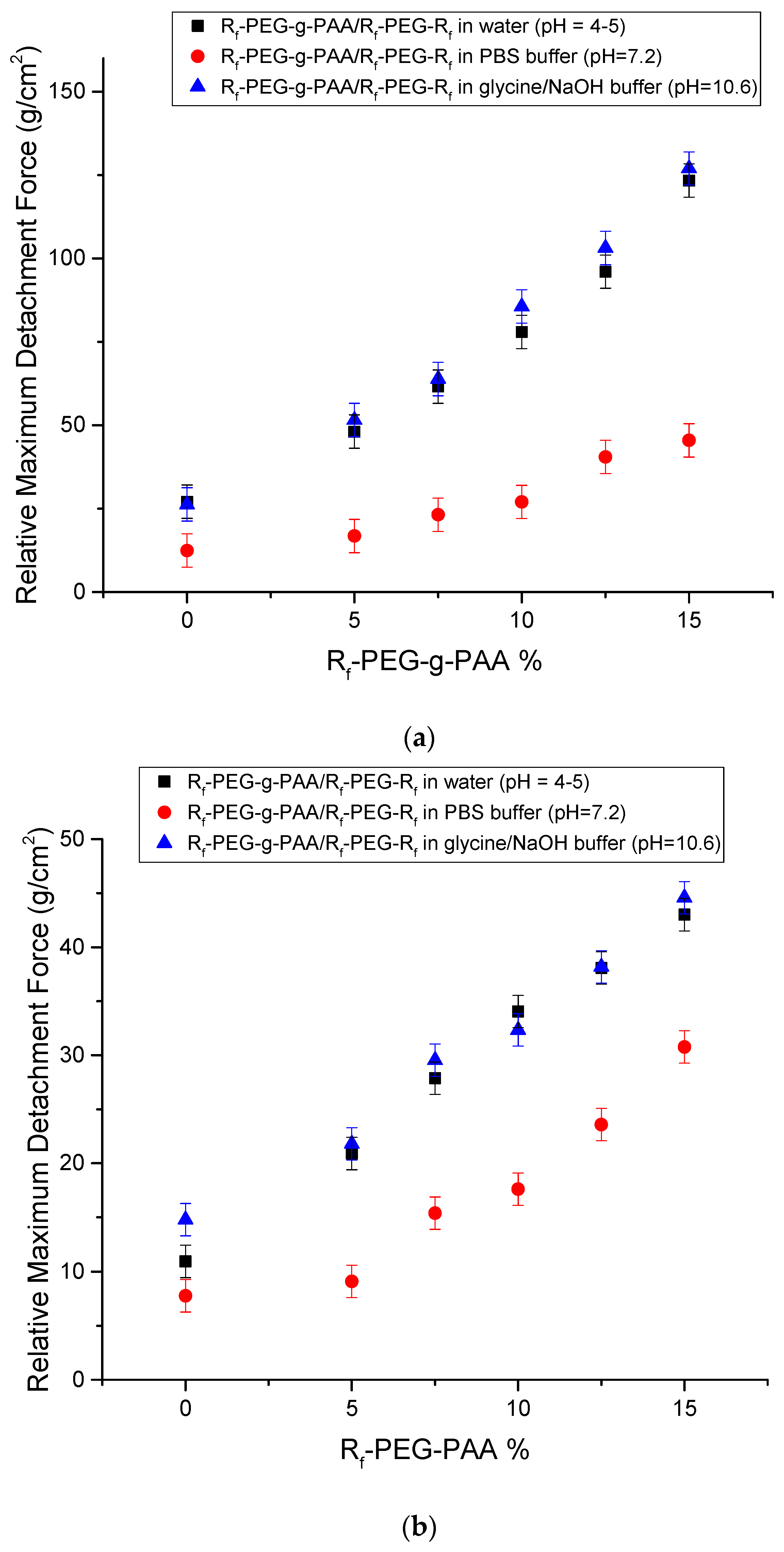
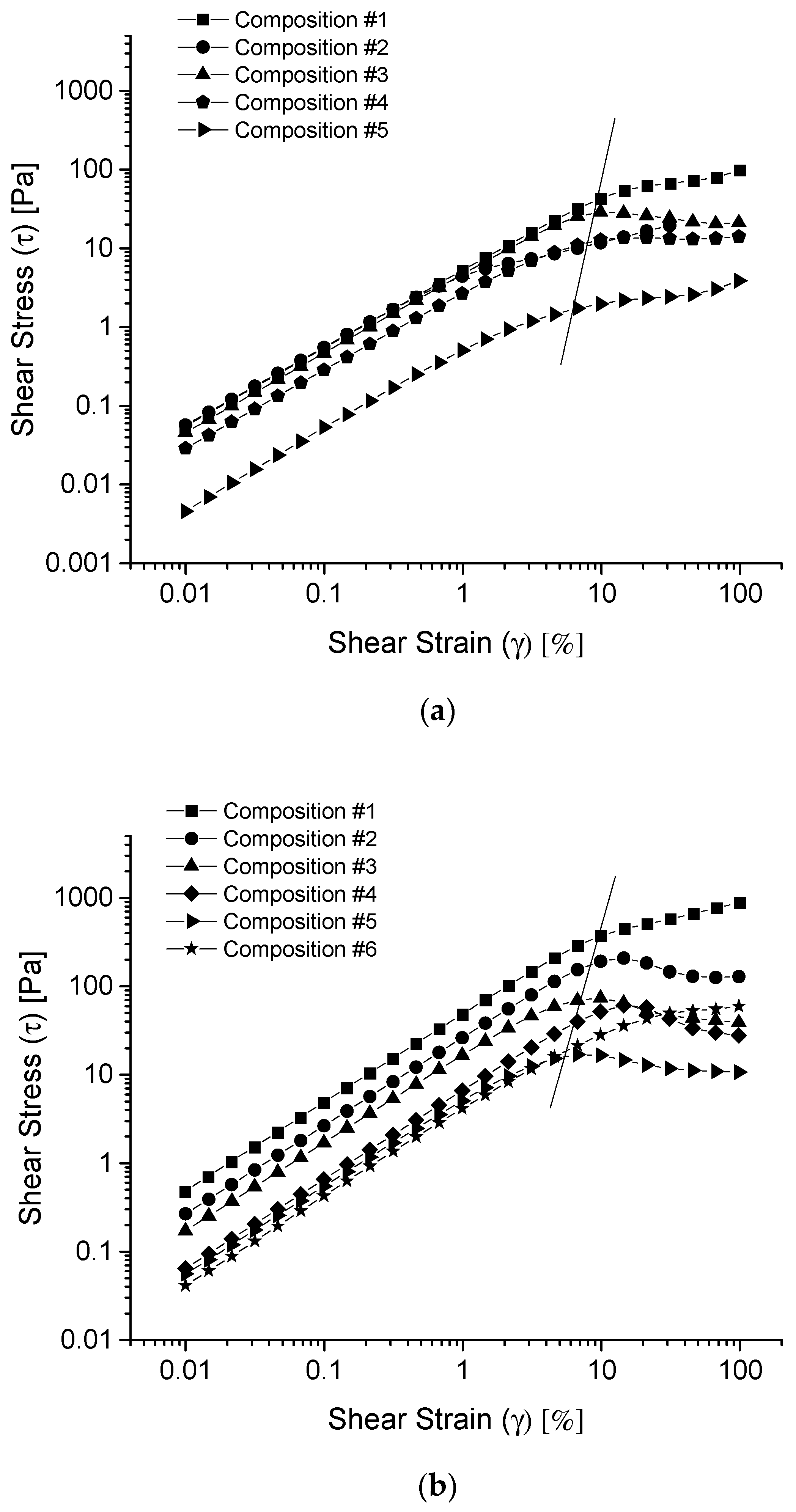


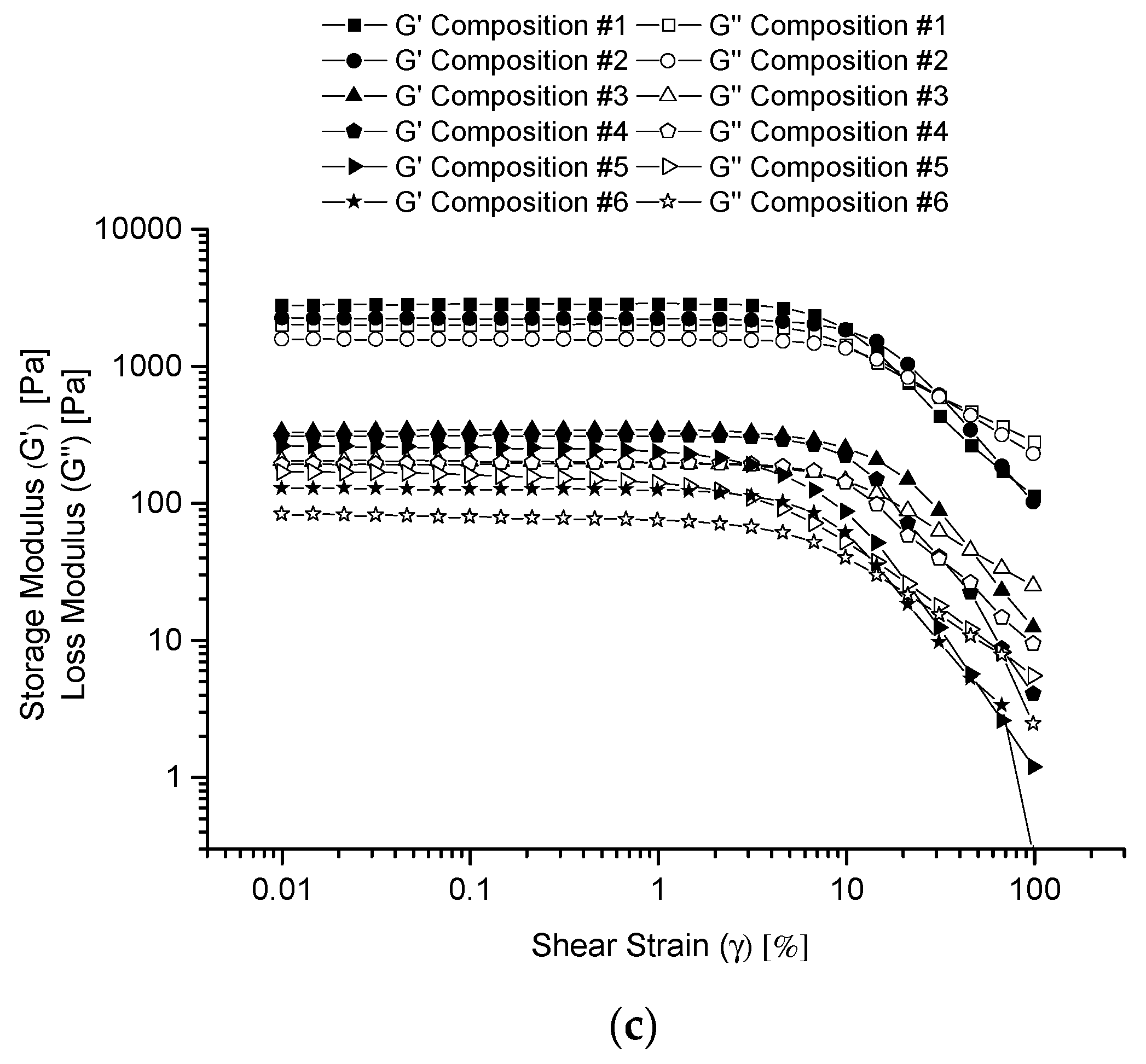
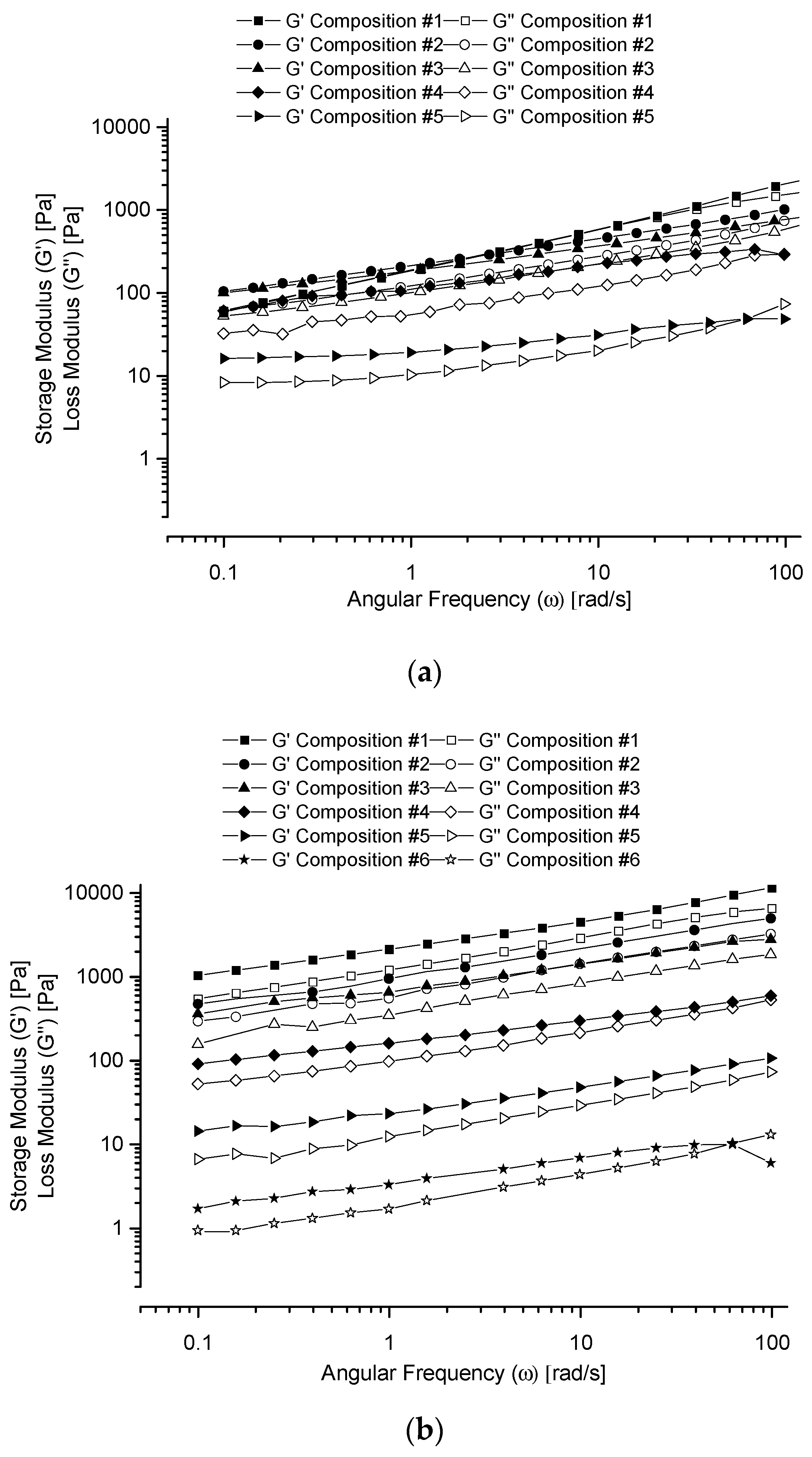
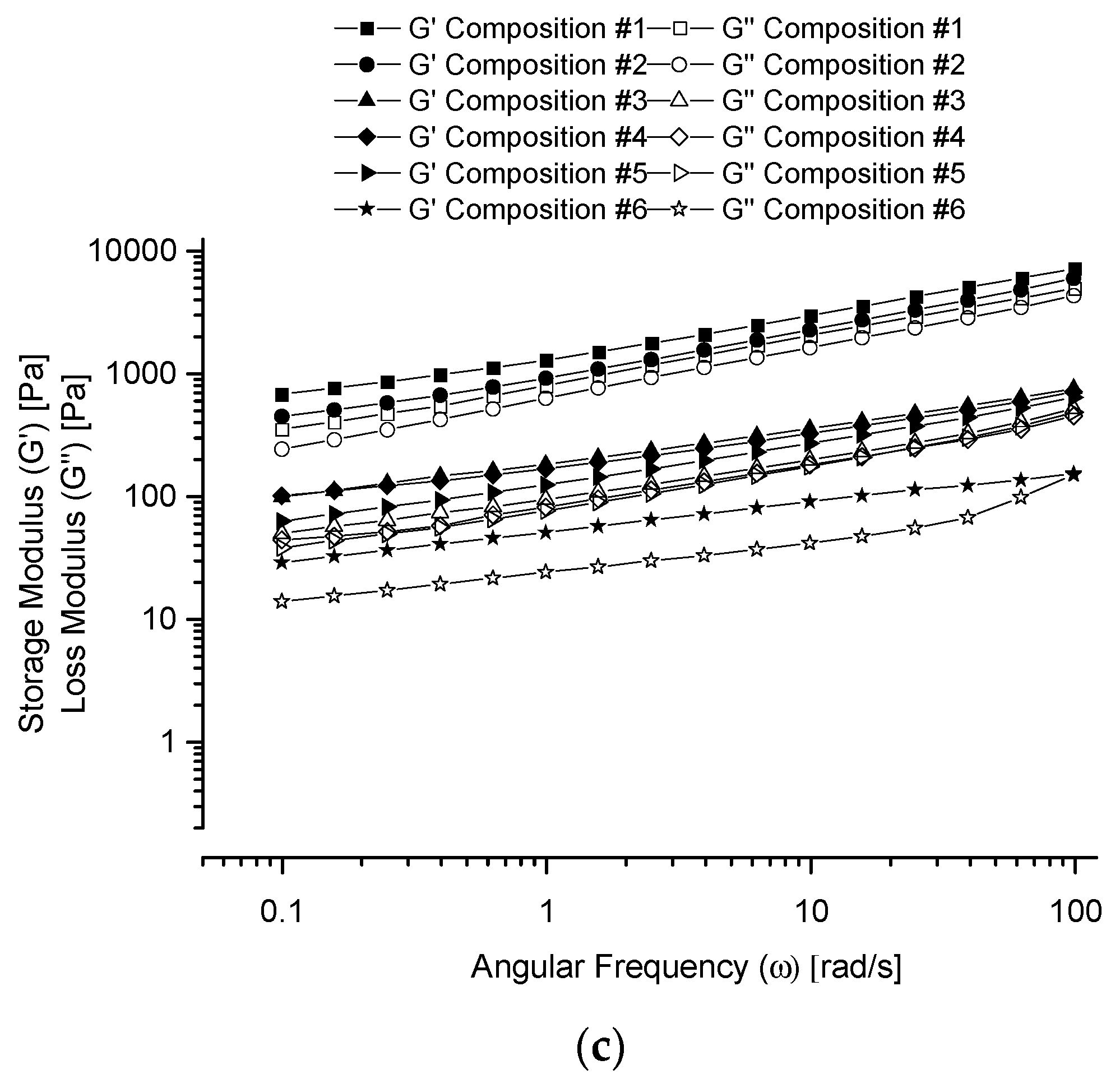
| Composition # | Rf-PEG-Rf wt% | Rf-PEG-g-PAA wt% | PAA wt% |
|---|---|---|---|
| 1 | 100.0 | 0.0 | 0.0 |
| 2 | 95.0 | 5.0 | 0.0 |
| 3 | 92.5 | 7.5 | 0.0 |
| 4 | 90.0 | 10.0 | 0.0 |
| 5 | 87.5 | 12.5 | 0.0 |
| 6 | 85.0 | 15.0 | 0.0 |
| 7 | 80.0 | 20.0 | 0.0 |
| * 8 | 95.0 | 0.0 | 5.0 |
| * 9 | 90.0 | 0.0 | 10.0 |
| * 10 | 0.0 | 5.0 | 0.0 |
| * 11 | 0.0 | 10.0 | 0.0 |
Publisher’s Note: MDPI stays neutral with regard to jurisdictional claims in published maps and institutional affiliations. |
© 2021 by the authors. Licensee MDPI, Basel, Switzerland. This article is an open access article distributed under the terms and conditions of the Creative Commons Attribution (CC BY) license (https://creativecommons.org/licenses/by/4.0/).
Share and Cite
Sun, Y.; Perez, A.F.; Cardoza, I.L.; Baluyot-Reyes, N.; Ba, Y. Mucoadhesive and Rheological Studies on the Co-Hydrogel Systems of Poly(Ethylene Glycol) Copolymers with Fluoroalkyl and Poly(Acrylic Acid). Polymers 2021, 13, 1956. https://doi.org/10.3390/polym13121956
Sun Y, Perez AF, Cardoza IL, Baluyot-Reyes N, Ba Y. Mucoadhesive and Rheological Studies on the Co-Hydrogel Systems of Poly(Ethylene Glycol) Copolymers with Fluoroalkyl and Poly(Acrylic Acid). Polymers. 2021; 13(12):1956. https://doi.org/10.3390/polym13121956
Chicago/Turabian StyleSun, Yang, Adiel F. Perez, Ivy L. Cardoza, Nina Baluyot-Reyes, and Yong Ba. 2021. "Mucoadhesive and Rheological Studies on the Co-Hydrogel Systems of Poly(Ethylene Glycol) Copolymers with Fluoroalkyl and Poly(Acrylic Acid)" Polymers 13, no. 12: 1956. https://doi.org/10.3390/polym13121956







